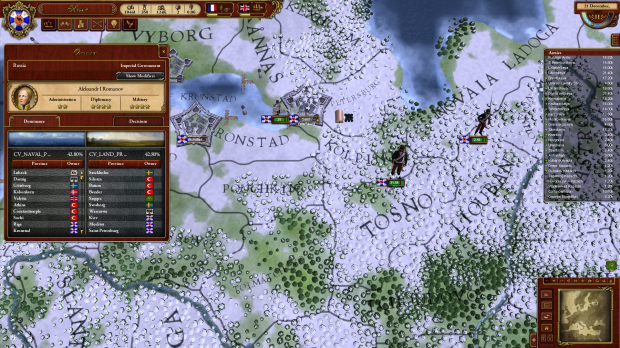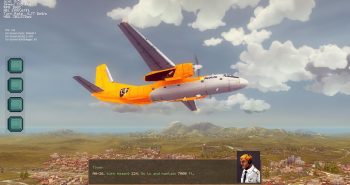The historical based strategy wargame has an interesting place in my heart. On one hand, as a trained historian and archaeologist, I love trying to either recreate or change history through my actions. On the other hand, I have never been any good at these games since I cannot seem to micro-manage the economic systems, while supplying my troops, and fighting a war on multiple fronts. This is similar to my love/hate relationship that I have with real time strategy games, but I am far more interested in the historical aspects of the wargame. This time around, I take on the Napoleonic Wars period of 1805-1815 with Paradox Interactive’s March of the Eagles.
Story:
March of the Eagles begins in 1805 with the start of the Napoleonic Wars. The Napoleonic Wars involved almost the entirety of Europe as Napoleon Bonaparte tried to expand the French Empire, mostly by trying to conquer the United Kingdom. The United Kingdom responded by gathering allies from all over Europe to form coalitions, seven of these by the end of the wars. The end result of the Napoleonic Wars was the removal from power of Napoleon Bonaparte and the strengthening of nationalism throughout Europe, eventually leading to the rise in power of both Germany and Italy by the end of the century. All of these is portrayed in March of the Eagles in one form or another, though for most individuals, it will be quite overwhelming.
The story line of March of the Eagles doesn’t play out in any type of narrative sense, like most games. There aren’t any talking heads nor cut scenes to show you what is occurring on the other side of the continent. The narrative is completely driven by your actions and what nation you choose to begin with. If you choose France, then the objective is fairly simple: Conquer Europe. If you choose any other nation, then the story will change as will the objectives based on your decisions. As Russia, do you choose to ally yourself with France, setting up a massive pincer attack and crush Central Europe between two armies, then defeat the United Kingdom? Or, do you ally yourself with the United Kingdom and try to march your armies across several hostile countries to join the fight against France? It is entirely up to the player and the decisions the player makes. The implementation of historical events in a game such as March of the Eagles is extremely tricky. You have to have the artificial intelligence react accordingly to player decisions. I felt that Paradox Interactive did a good job in recreating the political tension and setting for the Napoleonic Wars.
Game Play:
In a word, the game play of March of the Eagles was overwhelming. I felt that I had too much to keep track of in too many menus, but this is a personal critic of the game. Die hard fans of the strategy wargame genre may feel completely opposite, however, I definitely had issues with this. Fighting back my fear of menus and information overload, I got to see what March of the Eagles had to offer, and it is solid.
After choosing your nation, you are immediately thrown into the conflict. Since most nations already had wars, enemies, and allies ongoing before the start of the Napoleonic Wars, you have some immediate decisions to make. Russia, for instance, is already entangled with Persia to the south before I even make one alliance to involve myself in the greater conflict of Europe.
Decisions made for your nation are presented and completed through menus. Decisions involving Diplomacy, Research, and Manufacturing are all presented in extensive and detailed menus, which quite frankly gave me information overload. However overwhelming as it was for me, having this information is beneficial for those that take their wargame simulators seriously.
Aesthetics:
March of the Eagles is not a pretty game, at all. The icons for all troops are those of infantry, even if the troop type is cavalry, which makes it hard to identify troop types at a glance. Animations are at a minimal and the map, while showing detailed topography across Europe, isn’t attractive at all. The good news in this regard is that March of the Eagles fully supports user made modifications, and there is already a mod in works from the community to make this a more visually appealing game. Unfortunately, I see that has a huge strike against March of the Eagles. When your customers have to fix your product to make it more appealing, then you haven’t done your job right.
The sound of March of the Eagles wasn’t memorable either. Since there is no voice acting, no conflict sound effects, and very little ambient sounds, I don’t have much to review. The music works, however, isn’t something you will find whistling at work later in the day.
Final Thoughts:
March of the Eagles is a very strong contender in the historical wargame genre. This historic era is under-represented in today’s video game market and is a fantastic change of pace from playing games based on either World War II or conflicts centered in the Middle East. This game is not for everyone! You must constantly micro-manage your finances, diplomacy, research, and troop movement in order to remain a contender in the Napoleonic Wars power struggle. Information is your best friend, and worst enemy in March of the Eagles. You can see almost everything with a click of the mouse button, but this could lead to information overload for those of you that are not wargame veterans. The aesthetics of March of the Eagles leaves much to be desired, but that has been the case in most historical wargames. I hope that this style of game will continue to be made in the future, however, I hope developers start borrowing ideas from other developers, like Blizzard, and start putting more into how the game looks and sounds. Overall, March of the Eagles is a very strong game for those that have the desire to rewrite history in a strategy game and you get a lot for the $20 price tag.
[easyreview title=”March of the Eagles Review Score” cat1title=”Overall Score (out of 5)” cat1detail=”” cat1rating=”3″ ]






